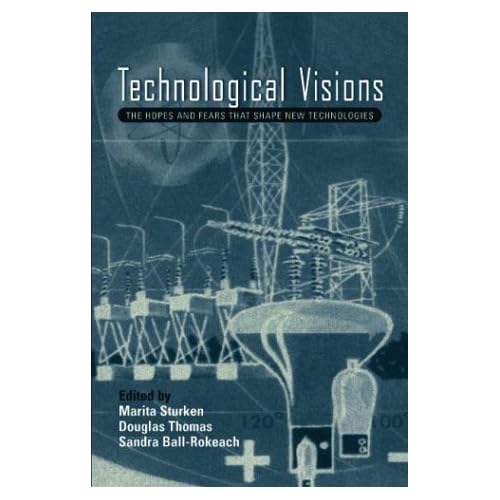In between the Statistical Analysis Software programming sessions, I have been reading a very interesting book about perspectives of modern technology. How the new electronic gadgets and Web-based services influence, shape or threaten our way of life? Why do we engage in virtual communities? How good have we been in predicting a future technology? What kind of technology is yet to come? What is the attitude of the culture towards technological progress? Where does the Internet fit into the globalization process? These are some of the question that this anthology's essays arise.
 The book Technological Visions: The Hopes and Fears that Shape New Technologies is a result of a project funded and covered by the Annenberg Foundation through three foundation's organizations. Both Annenberg Schools for Communication, at the University of Pennsylvania and at the University of Southern California, as well as The Annenberg Center for Communication at the University of Southern California, contribute a majority of authors in this volume.
The book Technological Visions: The Hopes and Fears that Shape New Technologies is a result of a project funded and covered by the Annenberg Foundation through three foundation's organizations. Both Annenberg Schools for Communication, at the University of Pennsylvania and at the University of Southern California, as well as The Annenberg Center for Communication at the University of Southern California, contribute a majority of authors in this volume.
A selection of studies for this book has been made by then three professors in the Annenberg School for Communication at the USC. Marita Sturken, Douglas Thomas and Sandra J. Ball-Rokeach are also multiple books authors. M. Sturken teaches now at the New York University.
Out of book's18 essays, I picked two for my review. My selection of essays has been made, partly based on a fact that I am regularly participate in a few virtual communities, partly on my primary educational program at the university, and that is statistical and data analysis.These two essays are: When the Virtual Isn't Enough by Katie Hafner and The Globalization of Everyday Life: Visions and Reality by group of authors: Jennifer L. Gibbs, Sandra J. Ball-Rokeach, Joo-Young Jung, Yong-Chan Kim, and Jack Linchuan Qiu.
When the Virtual Isn't Enough
Katie Hafner describes similarities and differences between a real-life community and a virtual community on two vibrant examples. A 2500 residents of the town of Williamsburg, Massachusetts, turned out to be impressive and so much needed support for the author in times of mourning after her tragically deceived father.
Five days after the accident, 200 people, perhaps even more, walked up the hill to the town cemetery to attend Neil's graveside funeral. A month later, at a gathering at my father's house following his memorial service, women from the church materialized, like angels out of nowhere, to serve food and clean up.
Williamsburg is a small community, where people virtually know each other's secrets. Regardless, their care for the offspring of one of "theirs", late Neil, was a healing factor for Katie. She says that after she had spend a week in a town, she did not want to leave. Even though she did not know these people well, they kept her safe and warm.
When I did leave, although I stayed in touch with many of these same people by e-mail and telephone from northern California, I felt too far away and wanted to return.
She describes how her staying in her late father's town gave her better insight of the meaning of the community. The interesting part is that, prior to the describe event, she had been studying a case of a well-known virtual community WELL for years. It came naturally for her to compare her experience regarding the virtual and the real in a domain of what we call community.
The name for the WELL is a handy word puzzle. Well stands for The Whole Earth 'Lectronic Link. Also, when added a domain extension ".com", we pronounce the whole web-address as "www welcome", that, I must say, obviously, sounds welcoming enough. The web address, itself, is www.well.com.
The WELL is a virtual community. It was started back in 1985 in California by web-veterans Stewart Brand and Larry Brilliant. Several well-known names were part of the WELL community, such as John Perry Barlow, John Gilmore, and Mitch Kapor, the founders of the Electronic Frontier Foundation, or even Kevin Mitnick himself, to name a few. It may be worth to note that Kevin Mitnick was refused to extend his membership in the WELL in March 2007. Does that speak of WELL's high morale or hypocrisy, judge for yourself.
Author speaks about the WELL as a community, which despite of being virtual, inherits many characteristics of a real-life community. It has it code of behavior, an established format for posts, it's "do's and don't's".
Just like in real life exist individuals, who oppose established social boundaries, and who, by expanding them according to their standards, impose the new standards, and become famous just for that fact, the WELL had it's star. The author focused her research of the virtual community on one member, who she calls the quintessential member. Tom Mandel was THE single most important and visible member of the community. He worked at Stanford Research Institute in Menlo Park as a futurist, one of the first to receive such a degree in USA. He was smart, fast in typing on a keyboard, temperamental and eclectic, as the author says. He was a real hero and star of the WELL, a sort of an early model for other virtual community eccentric members.
Mandel's more or less continuous presence on the WELL made him something of an ever-present force. He provoked, bullied, jeered, one-lined, and pontificated his way around the WELL.
Doesn't this sound familiar? Nowadays, every Internet discussion forum, that has achieved a critical mass of members, gives a sort of birth to it's own hero. Discussion forum is a media-content channel for it's users, and every media has it's own stars. Be it TV-channel, radio station, web-portal or newspapers, there is always that distinguished individual, who's persona brings it on.
Tom Mendel resembles in a way a TV performance artist Andy Kaufmann, or a 1990s MTV star Tom Green, or a modern satellite-radio- and tv- and media- star Howard Stern, to mention a few. Every single one of them were setting the new rules for others to follow in their respective media. Furthermore, they were having fun, along the way.
Author comes to a conclusion that virtual communities cannot replicate the real thing. It was her father's death, that enabled her to experience the irreplaceable:
... a sense of place, a sense of belonging, in a physical way.
... want to gossip about marital troubles of those nasty neighbors...
... want their new car to be seen...
This essay learns us that virtual communities are a replacement, or a sort of an artificial extension for a missing chunks of life. They, communities, are addictive, they are safe, and anonymous. They ultimately remain virtual, but not real.
The other chosen work from the book Technological Visions, that I chose to review, is an analytical essay:
The Globalization of Everyday Life: Vision and Reality.
This is a final essay of the book, a joint analysis of communications aspect of globalization. A team of researchers from the University of Southern California, under the Metamorphosis Project research how modern technology affect lives of several ethnically selected and geographically separated focus groups of people in a wider residential area of Los Angeles. Following ethnic groups have been researched: Caucasian/Protestant, Caucasian/Jewish, African American, Mexican, Central American, Korean, and Chinese.
Jennifer L. Gibbs, Sandra J. Ball-Rokeach, Joo-Young Jung, Yong-Chan Kim, and Jack Linchuan Qiu performed a quantitative and qualitative analysis in this study, and revealed some interesting results.
When describing the term globalization, the groups' description of term is highly similar when it comes to language. However, perception of globalization varies from highly positive, among African- and Central Americans, to skeptical among Korean-origin focus group. Chinese-origin focus group was ambivalent on this issue.
Caucasian groups' ambivalence towards globalization is additionally explained by cynicism based on injustice, that comes with globalization process. They consider the Internet to be both positive and dangerous: "a double-edged sword".
Most interesting results were received when it comes to modern technology-based communicational habits of focus groups. Study results for all groups differ accordingly to the generation of immigrants. Internet communication behavior of first- and second- generation immigrants is different from those of third generation or more. Authors use the term ethnoscapes by Arjun Appandurai, by which they describe ability of ethnic displaced groups to reconnect to their homeland via available communication technology, whether it is Internet or traditional media.
The study shows that the global Internet connections are global to extend of ability of ethnoscapes to inner-communicate. This means that, unlike globalization technological vision, groups use modern communication technology to reconnect with home country.
Finally, the most important conclusion of the study is that the global Internet interconnectivity does not alter people's lives in a way, that the actual physical migrations bring people with various ethnic and cultural background together . The ethnicity remains strong dividing factor between people even on Internet.
What a defeat for us all, I must add...




0 comments:
Post a Comment